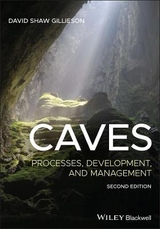
Caves
Blackwell Publishers (Verlag)
978-0-631-19175-9 (ISBN)
- Titel ist leider vergriffen;
keine Neuauflage - Artikel merken
This book describes caves as physical, geological, and biological phenomena: it provides explanations of how they form, what can be learnt from them, and how they can best be managed for the benefit of future generations. The limestone caves of the world have long been of importance to people for shelter, water supply, food, spirituality and for defense. They have long provoked awe and a sense of mystery. Cave science is now well established to elucidate their mystery. The volume opens with an examination of contemporary processes of cave development, and of cave underground drainage basins with characteristic three-dimensional mazes of connected passages. It describes the details of cave hydrology, involving water tracing and isotope analysis, along with the processes of solution of limestone and other caves forming rocks such as sandstone and gypsum. The author then moves to past processes. Caves are nature's vaults, preserving the products of landscape processes unaltered for millennia. He shows how much has and could further be learnt about past ecologies, early human culture, and climatic change from the analysis of cave formations, bone deposits and sediments.
The final part of the book is devoted to a discussion of cave ecosystems and their management. Dr Gillieson looks at the unusual adaptations of plants and animals to cave living and the functioning of cave ecosystems. He discusses how caves have and should be managed for recreation and for water supply, as well as the need to manage the surface terrain above the caves, and for environmental planning in limestone areas more generally. This book is aimed at students of the natural environment, but it will also appeal to those - cavers, environmental managers and field naturalists - who are curious about the underground world and its inhabitants. It is illustrated throughout with photographs, maps and line diagrams, almost all of which are original to the book.
David Gillieson is Senior Lecturer in the School of Geography and Oceanography, University College, University of New South Wales. He has previously held appointments at the University of Queensland and the Australian National University. Over the last twenty five years he has explored and studied caves in Australasia, Europe, North America, Oceania and Southeast Asia.
Preface and Acknowledgements. List of Figures. List of Plates. List of Tables. 1. The Cave System and Karst. 2. Cave Hydrology. 3. Processes of Cave Development. 4. Cave Formations. 5. Cave Sediments. 6. Dating Cave Deposits. 7. Cave Deposits and Past Climates. 8. Cave Ecology. 9. Cave Management. 10. Catchment Management in Karst. References. Further Reading. Glossary. Index.
| Erscheint lt. Verlag | 17.11.1996 |
|---|---|
| Reihe/Serie | Natural Environment |
| Verlagsort | Oxford |
| Sprache | englisch |
| Maße | 194 x 234 mm |
| Gewicht | 652 g |
| Themenwelt | Naturwissenschaften ► Geowissenschaften ► Geologie |
| ISBN-10 | 0-631-19175-5 / 0631191755 |
| ISBN-13 | 978-0-631-19175-9 / 9780631191759 |
| Zustand | Neuware |
| Haben Sie eine Frage zum Produkt? |
aus dem Bereich



